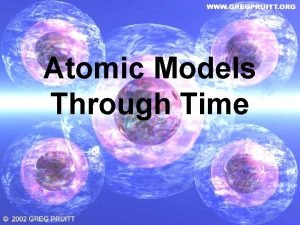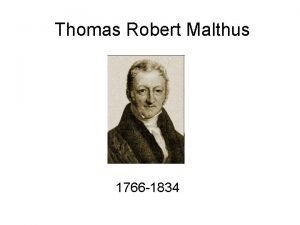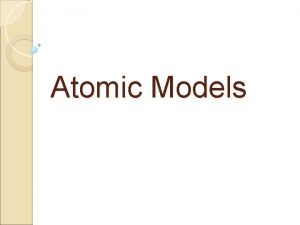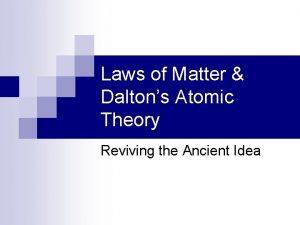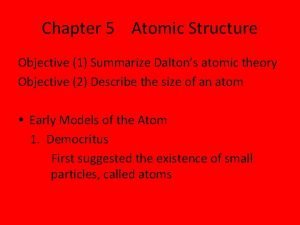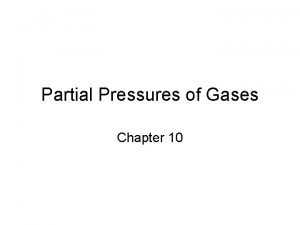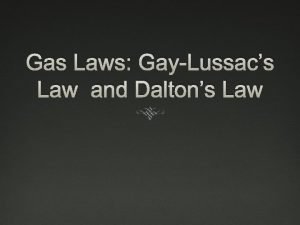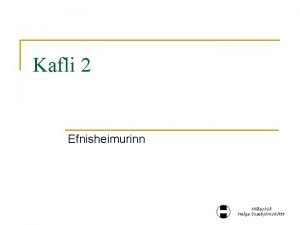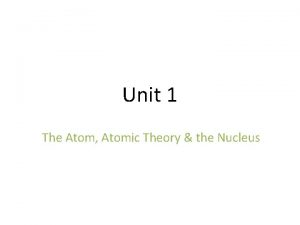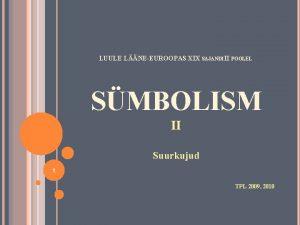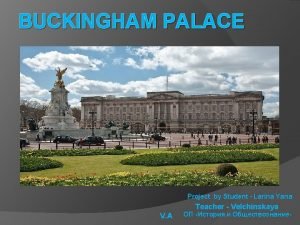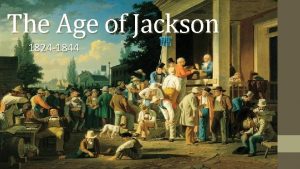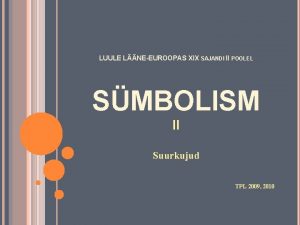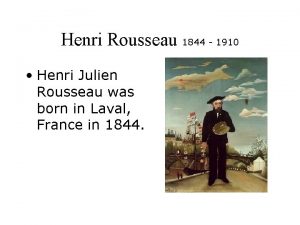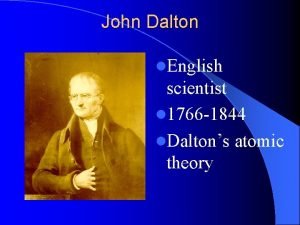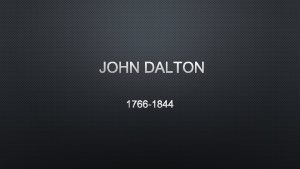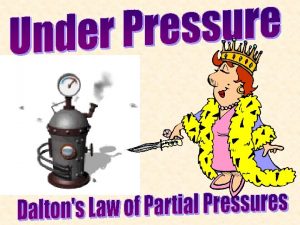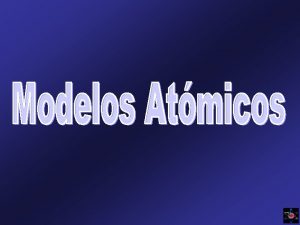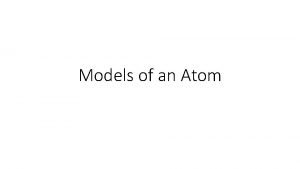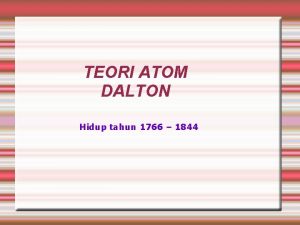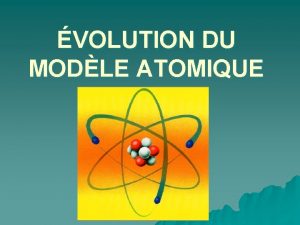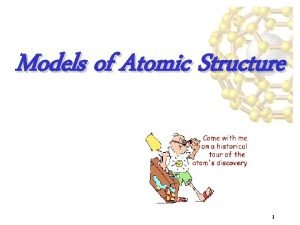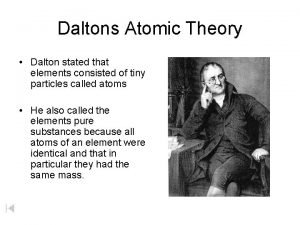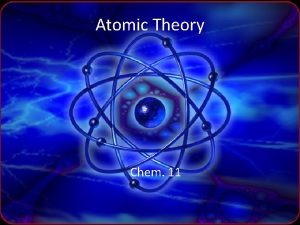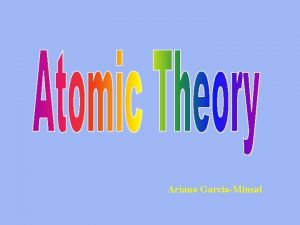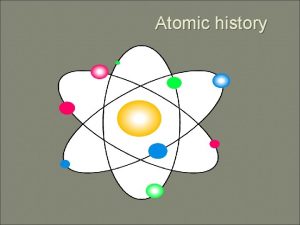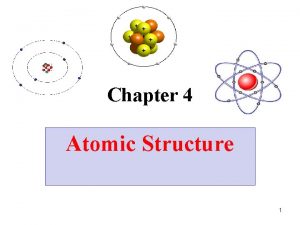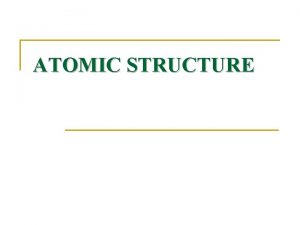Daltons Atomic Theory John Dalton 1766 1844 proposed

















- Slides: 17

Dalton’s Atomic Theory John Dalton (1766 -1844) proposed an atomic theory While this theory was not completely correct, it revolutionized how chemists looked at matter and brought about chemistry as we know it today instead of alchemy Thus, it’s an important landmark in the history of science.

Dalton’s Atomic Theory - Summary 1. matter is composed, indivisible particles (atoms) 2. all atoms of a particular element are identical 3. different elements have different atoms 4. atoms combine in certain whole-number ratios 5. In a chemical reaction, atoms are merely rearranged to form new compounds; they are not created, destroyed, or changed into atoms of any other elements.

Problems with Dalton’s Atomic Theory? 1. matter is composed, indivisible particles Atoms Can Be Divided, but only in a nuclear reaction 2. all atoms of a particular element are identical Does Not Account for Isotopes (atoms of the same element but a different mass due to a different number of neutrons)! 3. different elements have different atoms YES! 4. atoms combine in certain whole-number ratios YES! Called the Law of Definite Proportions 5. In a chemical reaction, atoms are merely rearranged to form new compounds; they are not created, destroyed, or changed into atoms of any other elements. Yes, except for nuclear reactions that can change atoms of one element to a different element

ATOM COMPOSITION The atom is mostly empty space • protons and neutrons in the nucleus. • the number of electrons is equal to the number of protons. • electrons in space around the nucleus. • extremely small. One teaspoon of water has 3 times as many atoms as the Atlantic Ocean has teaspoons of water.

ATOMIC COMPOSITION • Protons (p+) – – – + electrical charge mass = 1. 672623 x 10 -24 g relative mass = 1. 007 atomic mass units (amu) but we can round to 1 • Electrons (e-) negative electrical charge – relative mass = 0. 0005 amu but we can round to 0 – • Neutrons (no) no electrical charge – mass = 1. 009 amu but we can round to 1 –

Atomic Number, Z All atoms of the same element have the same number of protons in the nucleus, Z 13 Al 26. 981 Atomic number Atom symbol AVERAGE Atomic Mass

Mass Number, A • C atom with 6 protons and 6 neutrons is the mass standard • = 12 atomic mass units • Mass Number (A) • • = # protons + # neutrons NOT on the periodic table…(it is the AVERAGE atomic mass on the table) A boron atom can have A = 5 p + 5 n = 10 amu

Isotopes • Atoms of the same element (same Z) but different mass number (A). • Boron-10 (10 B) has 5 p and 5 n • Boron-11 (11 B) has 5 p and 6 n 11 B 10 B

Figure 3. 10: Two isotopes of sodium.

Atomic Symbols l Show the name of the element, a hyphen, and the mass number in hyphen notation sodium-23 l Show the mass number and atomic number in nuclear symbol form mass number 23 Na atomic number 11

Isotopes? Which of the following represent isotopes of the same element? Which element? 234 92 X 234 93 X 235 92 X 238 92 X

Counting Protons, Neutrons, and Electrons • Protons: Atomic Number (from periodic table) • Neutrons: Mass Number minus the number of protons (mass number is protons and neutrons because the mass of electrons is negligible) • Electrons: – If it’s an atom, the protons and electrons must be the SAME so that it is has a net charge of zero (equal numbers of + and -) – If it does NOT have an equal number of electrons, it is not an atom, it is an ION. For each negative charge, add an extra electron. For each positive charge, subtract an electron (Don’t add a proton!!! That changes the element!)

Learning Check – Counting Naturally occurring carbon consists of three isotopes, 12 C, 13 C, and 14 C. State the number of protons, neutrons, and electrons in each of these carbon atoms. 12 C 6 13 C 6 14 C 6 #p+ _______ #no _______ #e- _______

Answers 12 C 6 13 C 14 C 6 6 #p+ 6 6 6 #no 6 7 8 #e- 6 6 6

Learning Check An atom has 14 protons and 20 neutrons. A. Its atomic number is 1) 14 2) 16 3) 34 B. Its mass number is 1) 14 2) 16 3) 34 C. The element is 1) Si 2) Ca 3) Se D. Another isotope of this element is 1) 34 X 2) 34 X 3) 36 X 16 14 14

AVERAGE ATOMIC MASS 11 B 10 B • Because of the existence of isotopes, the mass of a collection of atoms has an average value. • Boron is 20% 10 B and 80% 11 B. That is, 11 B is 80 percent abundant on earth. • For boron atomic weight = 0. 20 (10 amu) + 0. 80 (11 amu) = 10. 8 amu

Isotopes & Average Atomic Mass • Because of the existence of isotopes, the mass of a collection of atoms has an average value. • 6 Li = 7. 5% abundant and 7 Li = 92. 5% – Avg. Atomic mass of Li = _______ • 28 Si = 92. 23%, 29 Si = 4. 67%, 30 Si = 3. 10% – Avg. Atomic mass of Si = _______
 John daltons atom
John daltons atom Atomic structure timeline
Atomic structure timeline John dalton atomic theory
John dalton atomic theory Thomas robert malthus (1766-1834)
Thomas robert malthus (1766-1834) John dalton atomic model drawing
John dalton atomic model drawing Dalton's atomic theory was accepted because
Dalton's atomic theory was accepted because Summarize dalton's atomic theory
Summarize dalton's atomic theory Two flasks are connected with a stopcock
Two flasks are connected with a stopcock Daltons gas law
Daltons gas law Site:slidetodoc.com
Site:slidetodoc.com Daltons experiment
Daltons experiment Dalton atomic model diagram
Dalton atomic model diagram Prantsuse poeet 1844-1896
Prantsuse poeet 1844-1896 1844 room buckingham palace
1844 room buckingham palace The age of jackson 1824-1844
The age of jackson 1824-1844 Prantsuse poeet 1844-1896
Prantsuse poeet 1844-1896 1844 1910
1844 1910 The age of jackson 1824-1844
The age of jackson 1824-1844


